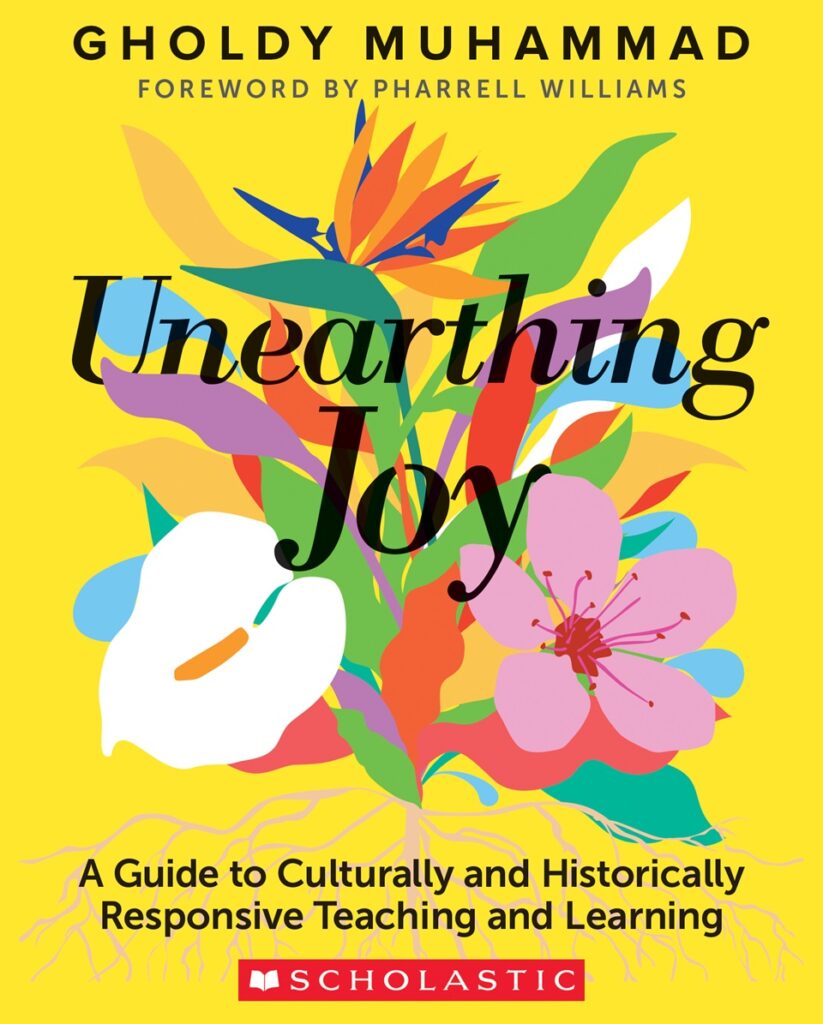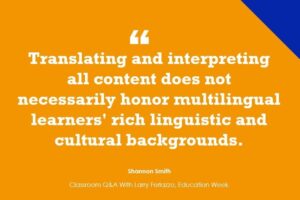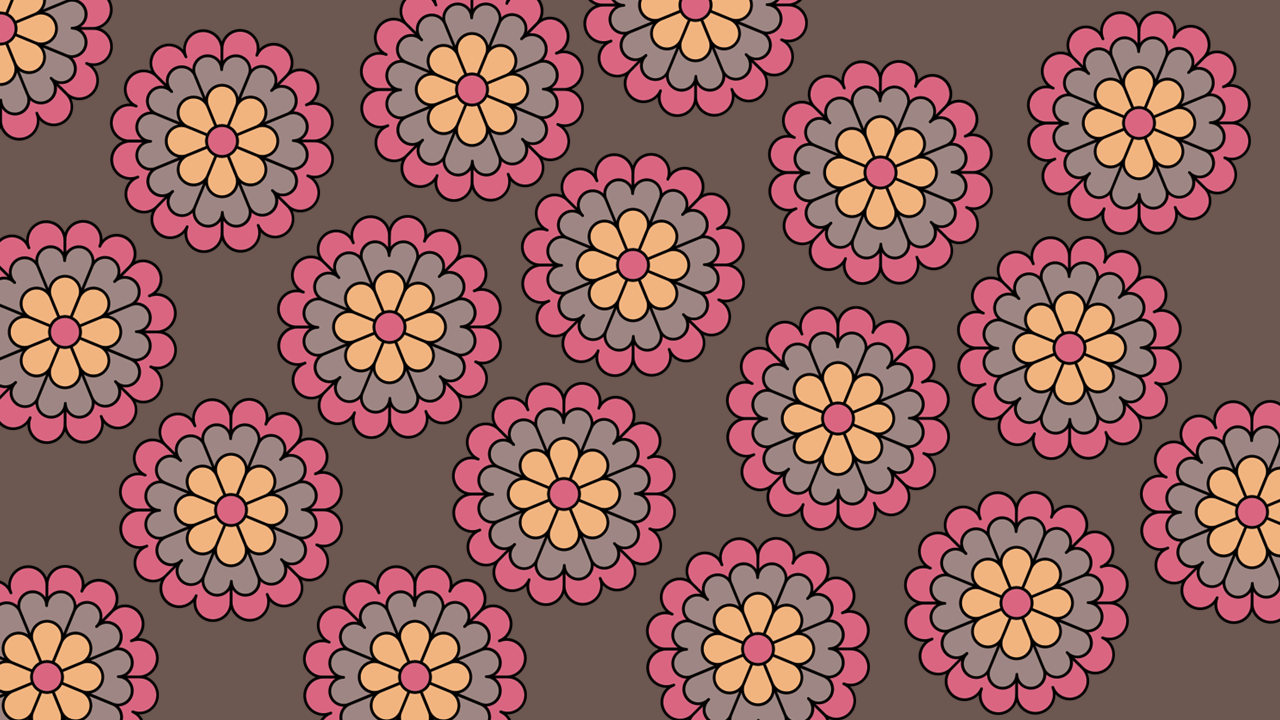
Bringing Joy Into Our Schools: A Conversation with Gholdy Muhammad
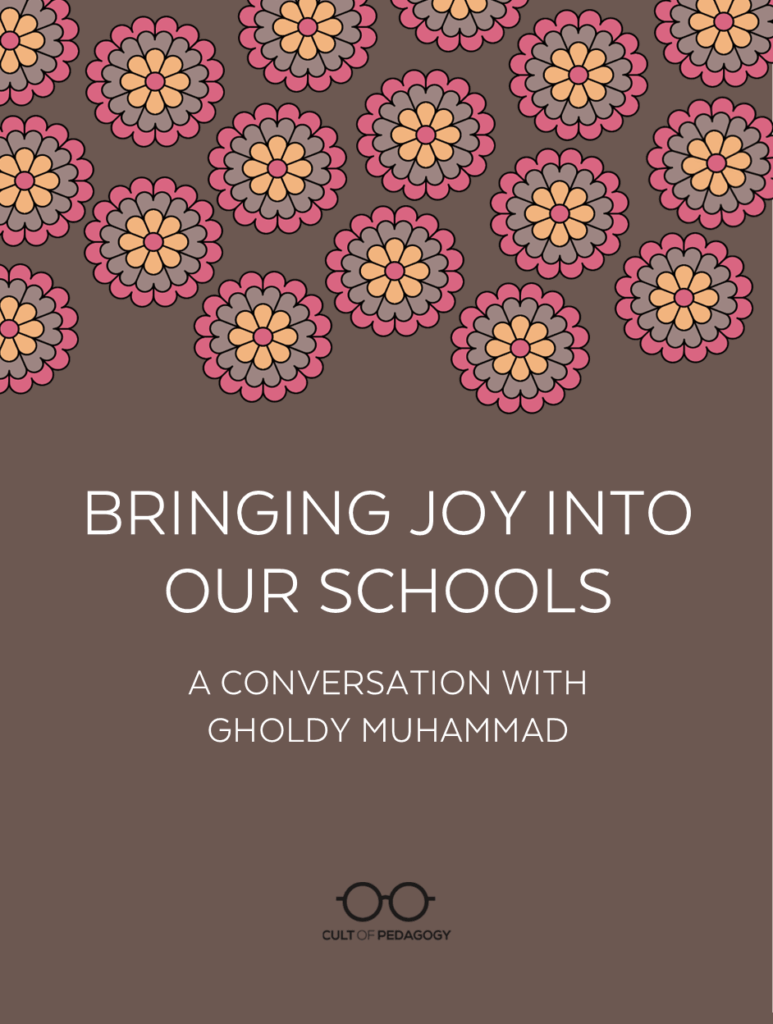
Listen to the interview with Gholdy Muhammad (transcript):
Sponsored by EVERFI and The School Me Podcast
This page contains Bookshop.org links. When you make a purchase through these links, Cult of Pedagogy gets a small percentage of the sale at no extra cost to you. What’s the difference between Amazon and Bookshop.org?
It would be an understatement, not to mention repetitive, for me to say that we’re living in very troubling times. And for teachers, many of those troubles are magnified. Policies seem to emerge every day that restrict what you can teach and strip away anything that looks like equity. The rights of your students and their families, along with your own, are being chipped away. In many communities, families are living with the constant fear of violence and separation. All of this is layered on top of the already high demands of teaching in a post-Covid world.
It’s exhausting. It’s demoralizing. And if you’re like a lot of teachers I’ve talked to lately, you might feel like you’re running out of reasons to keep going.
So why would I want to spend an hour talking about joy?
Because along with intermittently following the news and trying to distract myself from said news, I’ve been listening to the voices of people who have been through hard times before and still manage to lead with strength. One of the themes that I keep hearing from them is that building community and making space for joy are not “extras.” They’re survival strategies. They’re what make us stronger and more able to resist.
My guest today, Dr. Gholdy Muhammad, has been one of those voices for me.
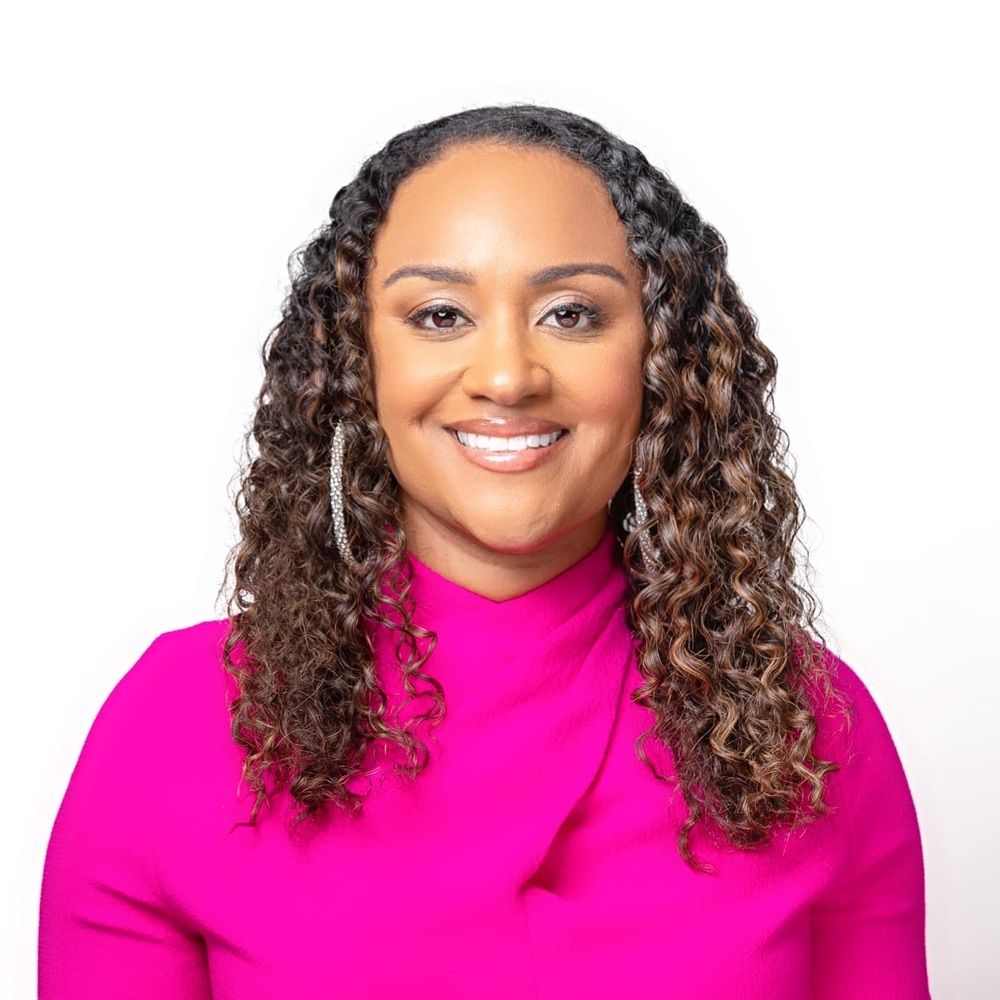
In 2020, on episode 151, Dr. Muhammad came onto the podcast to talk about her book Cultivating Genius, where she introduced her framework for Culturally and Historically Responsive Literacy. The goal of the framework is to make students’ education more “humanizing and complete” by building learning experiences around four pursuits: identity, skills, intellect, and criticality. Three years later, in her 2023 book Unearthing Joy, she added joy as a fifth pursuit. When the book was published, I put it on my list for possible interviews for the podcast, but it ended up getting pushed back over and over. Now I think that delay worked out for the best, because I think the world needs joy now even more than it did two years ago.
In this episode, we talk about why joy is a necessary pursuit, what to do if you’re working in a place where joy seems almost impossible, and what specific practices you can put in motion to bring joy into your classroom.
I’m finding that in 2025, I have to intentionally look for things that give me hope. This conversation definitely did that for me, and I hope it does the same for you.
How Joy Became the Fifth Pursuit
Muhammad explains that the addition of joy was born out of the pandemic, a time marked by loss, racial uprisings, and deep reflection. “Given the loss, the illness, the change, the shift, the confusion, and so much more in our country and the world,” she says, “I thought to myself, wow, we need joy more than ever.”
“I had written about joy in Cultivating Genius, but it was not a prominent pursuit. Like love, I just assumed that we were all doing joy every day. When I teach a lesson, it’s like joy city. And I assumed that perhaps we don’t have to be as intentional about it. It’s just innate. It’s already there. But it’s not for everyone. We need to be more intentional about our joy.”
Muhammad’s definition of joy is big. “Joy, I found, according to the Black ancestors, was something more than just having fun and celebrating. Joy is is that embodied feeling that you have once justice is achieved. Joy is a sense of belonging, of safety. It’s a feeling of peace and safety. Joy is wonder, imagination, and laughter, and creativity, and art, and music.”
And she insists it is just as important as the learning standards we all hold ourselves to.
“When we unearth joy, we are bringing rich experiences into the classrooms that children remember, that they feel loved by, that they feel invigorated by, that they feel a sensation throughout their body when they’re learning. That’s joy. We feel the difference and we remember it, but most of all, we learn. The goal is learning. The goal is not just fun or sensations. The goal is coming away elevated, higher, ascending. And that’s what joy offers, that ascension.”
Practices for Bringing Joy into the Classroom
Muhammad shared some of her favorite strategies for bringing joy into daily teaching:
Self-Reflection
Before teachers can fully engage in building a classroom where all five pursuits are explored, they should start with themselves, asking questions about their own relationship to each of the five pursuits.
- For identity, Muhammad offers questions like, “What have I learned about myself? What’s the genius of my culture and my people and my family, my background? Have I ever experienced marginalization based on any of my identities?”
- She urges them think about their skills, including their efficacy in the skills that they actually teach and their pedagogical skills.
- “For intellect,” she says, “I ask teachers to consider, how do you cultivate your genius? How do you learn new things to teach? Where do you discover new knowledge? How are you a lifelong learner?
- Questions for criticality include, “What types of injustices have you observed and personally experienced? And that’s important, because you don’t have to experience every kind of injustice to know that it’s real, right?”
- Finally, for joy, she asks, “When you walk into your building every day, do you feel like this is a place where I belong, that will nurture my genius and joy? You may not walk in happy, smiling every day. I don’t know if that’s realistic for any job. But you should feel like this is a place where I feel at peace, I feel at home, I feel safe, I feel like I belong, and that I can have the potential to live out my creativity as a teacher artist.” If the answer is no, it’s worth exploring why.
See Yourself as an Artist
This mindset shift gives teachers a different way of looking at their work. “We have to move from seeing curriculum just as a set of packaged materials to curriculum as storytelling, curriculum as the world around me, curriculum as the legacy I’m leaving,” Muhammad explains. “That’s what artists do. They leave timeless legacies.”
Layering Texts
“Typically, the textbook or the anchor text will not get to all five pursuits,” Muhammad says, “so I invite teachers to bring in short, powerful, multi-modal texts, videos, songs, memes, objects as texts. I taught a fourth grade unit a couple years ago on architecture, and I brought in some tools that architects use as texts. So texts can be anything that children can make sense of across the different modes.”
Student Spark
How we start a lesson can make the difference between one that falls flat and one that brings joy. “In that first 5, 10 minutes of the lesson,” Muhammad asks, “how are you going to ignite the flame for learning? How are you going to sort of gauge interest? And not just joyful interest but intellectual interest too. Because children, especially the older they get, they want to see purpose. Like, why am I learning this?”
Intentional Classroom Decor
“Sometimes we just put stuff on the wall just to fill up the paint on the wall space,” Muhammad says. “I just tell teachers be very intentional … how do we see the five pursuits? Do have things hanging up that might elicit skills or intellect or criticality and justice and joy? It can be as simple as what we put on the walls, the color, the people. Are we putting people on the walls who are still alive or just people who have passed on? They need to see math and science and language in the past, present, and future. The future of being in themselves. They need to see it being organized and clean. So use the five pursuits to think about what you put up around you in the environment. The materials you use. Are they joy giving?”
Rich, Collaborative Learning Experiences
Muhammad urges teachers to “move away from the packets and the worksheets,” and toward more “enriched, memorable learning experiences that are very collaborative in nature where students can creatively use their genius and their joy to learn whatever the topic is.”
Joy as Resistance
I closed our conversation with this question: With our current landscape, a lot of us feel very, very helpless in the face of all that’s going on in the world. What would you like to say to teachers about how joy can be both an act of courage and a form of resistance, especially right now when the world feels so unsafe for a lot of people?
Here’s what Muhammad said: “It’s the joy that’s going to keep us going, keep us waking up, keep us fighting. Joy is what lets us stay present, care for ourselves, and give our best to students, even when fear is trying to take over.”
“We have to remember history,” she continues. “We have to remember when we were in this state before. We may not have been physically alive perhaps — maybe we were, maybe we weren’t — but what happened? How did we come out of that? That gives me the hope, when I think about the ancestors. This is not anything new. Banning books, changing policy for a certain agenda that feels very inhumane or hurtful and harmful. This is not new, and our reactions, our responses must not be new either. I encourage educators to remember their joy so that they can keep going. Continue to act in kindness and love in humane ways, and maybe somebody will pick up and follow your lead, and maybe they won’t. And for those folks, we create boundaries and separation so it doesn’t affect our health. And we just keep going.”
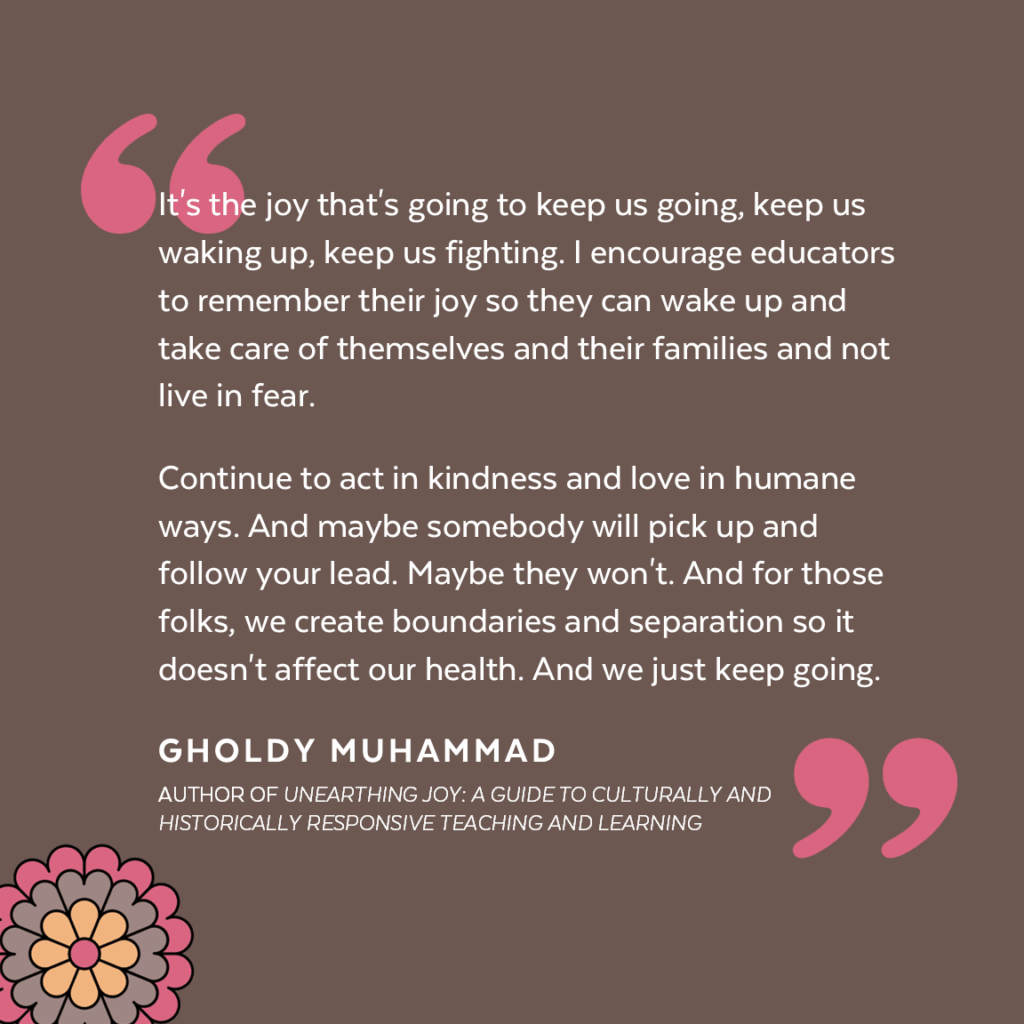
The Genius and Joy Curriculum
Muhammad’s newest project is a K–5 curriculum called Genius & Joy, created with a collaborative group she calls the “Genius Garden” and set to be released in Fall 2026. Each grade level gets six two-week units aligned to ELA standards with connections to other subjects, multicultural anchor texts, student journals tied to the five pursuits, parent letters, and guidance for localizing each unit to the community. Themes include identity, community & cultural diversity, environmental design, creativity and art, activism, and building the future.
Join our mailing list and get weekly tips, tools, and inspiration that will make your teaching more effective and fun. You’ll get access to our members-only library of free downloads, including 20 Ways to Cut Your Grading Time in Half, the e-booklet that has helped thousands of teachers save time on grading. Over 50,000 teachers have already joined—come on in.

